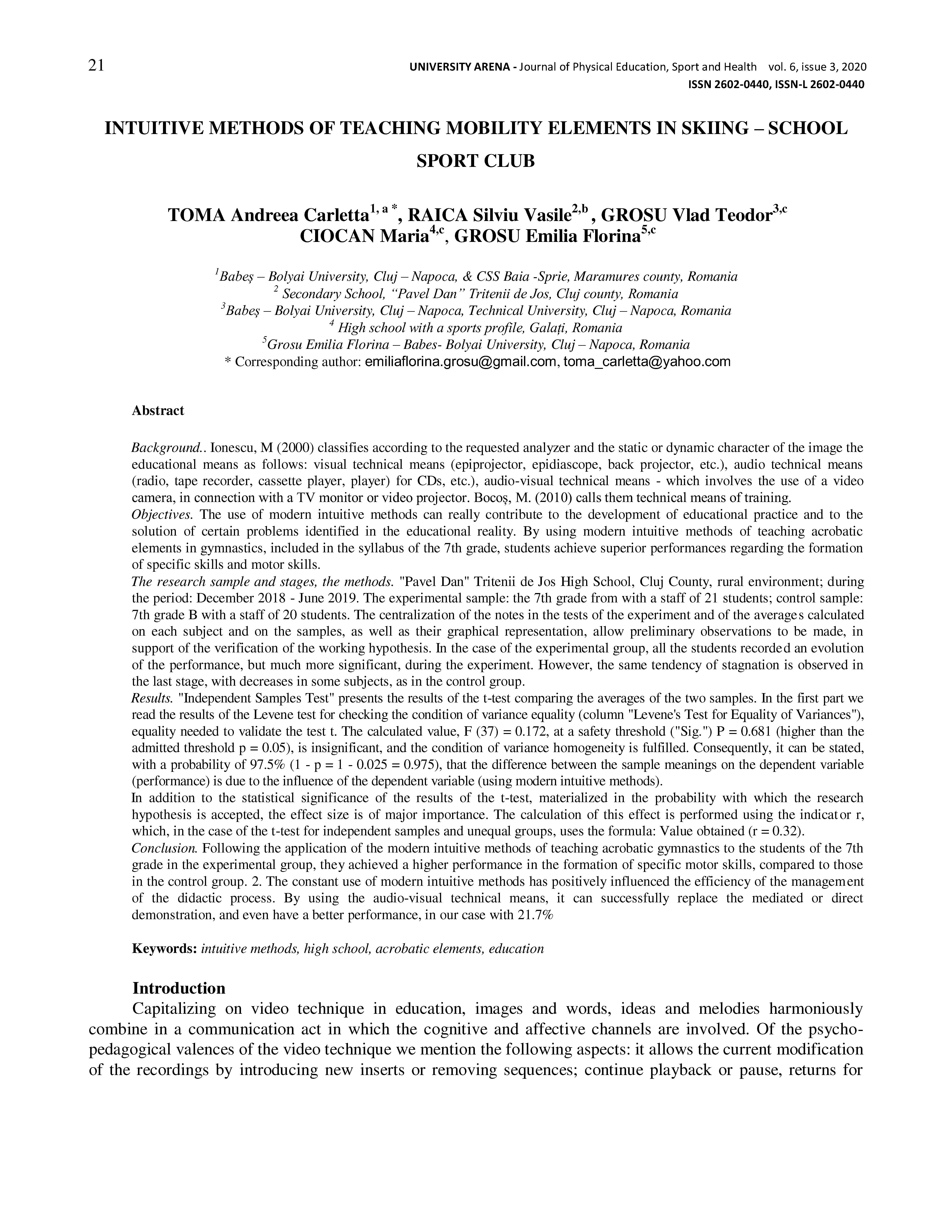INTUITIVE METHODS OF TEACHING MOBILITY ELEMENTS IN SKIING – SCHOOL SPORT CLUB
DOI:
https://doi.org/10.62229/UaVi_3_20-4Keywords:
intuitive methods, high school, acrobatic elements, educationAbstract
Background.. Ionescu, M (2000) classifies according to the requested analyzer and the static or dynamic character of the image the educational means as follows: visual technical means (epiprojector, epidiascope, back projector, etc.), audio technical means (radio, tape recorder, cassette player, player) for CDs, etc.), audio-visual technical means - which involves the use of a video camera, in connection with a TV monitor or video projector. Bocoș, M. (2010) calls them technical means of training.
Objectives. The use of modern intuitive methods can really contribute to the development of educational practice and to the solution of certain problems identified in the educational reality. By using modern intuitive methods of teaching acrobatic elements in gymnastics, included in the syllabus of the 7th grade, students achieve superior performances regarding the formation of specific skills and motor skills. The research sample and stages, the methods. "Pavel Dan" Tritenii de Jos High School, Cluj County, rural environment; during the period: December 2018 - June 2019. The experimental sample: the 7th grade from with a staff of 21 students; control sample: 7th grade B with a staff of 20 students. The centralization of the notes in the tests of the experiment and of the averages calculated on each subject and on the samples, as well as their graphical representation, allow preliminary observations to be made, in support of the verification of the working hypothesis. In the case of the experimental group, all the students recorded an evolution of the performance, but much more significant, during the experiment. However, the same tendency of stagnation is observed in
the last stage, with decreases in some subjects, as in the control group.
Results. "Independent Samples Test" presents the results of the t-test comparing the averages of the two samples. In the first part we read the results of the Levene test for checking the condition of variance equality (column "Levene's Test for Equality of Variances"), equality needed to validate the test t. The calculated value, F (37) = 0.172, at a safety threshold ("Sig.") P = 0.681 (higher than the admitted threshold p = 0.05), is insignificant, and the condition of variance homogeneity is fulfilled. Consequently, it can be stated, with a probability of 97.5% (1 - p = 1 - 0.025 = 0.975), that the difference between the sample meanings on the dependent variable (performance) is due to the influence of the dependent variable (using modern intuitive methods). In addition to the statistical significance of the results of the t-test, materialized in the probability with which the research
hypothesis is accepted, the effect size is of major importance. The calculation of this effect is performed using the indicator r, which, in the case of the t-test for independent samples and unequal groups, uses the formula: Value obtained (r = 0.32).
Conclusion. Following the application of the modern intuitive methods of teaching acrobatic gymnastics to the students of the 7th grade in the experimental group, they achieved a higher performance in the formation of specific motor skills, compared to those in the control group. 2. The constant use of modern intuitive methods has positively influenced the efficiency of the management of the didactic process. By using the audio-visual technical means, it can successfully replace the mediated or direct demonstration, and even have a better performance, in our case with 21.7%


